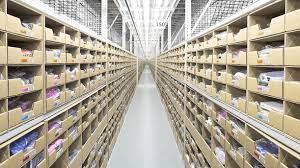Whether you’re running a fruit stand on the corner of your street, or a large margarine-making factory, packaging and shipping are an inevitable part of the process.
As a fruit stand owner, maybe it’s online orders that you have to fulfill that involve placing six apples and a plump tangerine in a box and having your guy deliver it to the customer’s doorstep.
As a margarine mogul, it’s carefully wrapping every margarine ‘brick’, or pouring the precious mass into cups of different sizes and then sealing them with lids. (It’s done differently depending on the manufacturer and the country.)
Anway, since running a factory is a more complex business, packing the bars into boxes, labeling each one, and then shipping them out onboard refrigerated trucks all represent the all-important ingredients of delivering goods from A to B.
In this article, we’ll concentrate on kitting – a process of varying complexity where you prepare finished products to be shipped to their destination. Some kitting operations are as simple as wrapping an apple in a paper bag. The others require placing the product in a large box with styrofoam padding, adding instruction manuals, additional parts, warranty, and other items as necessary.
In the passages below, we’ll explain why kitting is so essential for proper warehouse management. As you will see, the maxim of ‘preparation is half the battle’ works on the example of running a warehouse, too.
The benefits of kitting for proper warehouse management
When it comes to running a warehouse, it’s not just finding a large enough rental property and adding a couple of shelves.
To make everything run like clockwork, setting up a system where everything is done meticulously and carefully and where every box has its label is essential for ensuring that you don’t end up buried under a pile of unmarked boxes.
Kitting is just a part of a broader, more complex process that also involves bundling and shipping.
In short, kitting is taking a product that needs to be delivered and making a ‘kit’ out of it. Of course, the product itself is the central piece, but there are other important parts of this kit, such as wrapping paper, instruction manual, various accessories, and so on.
While typically a simple enough process, kitting is essential for making your warehouse run as smoothly as a greased lightning.
Here are some of the most important benefits of kitting in more detail.
Improved warehousing
Let’s say you know that an order is on, or that a product is in such high demand that you can make a bunch of finished bundles ready for shipping. During the process of making the bundle itself, you will have gotten rid of a lot of small, easy-to-displace parts that would otherwise take up valuable warehouse space.
Warehouses have been springing up worldwide like mushrooms after rain, in part to COVID19 and proliferation of e-commerce. For this reason, it’s extra important to keep your warehouse premises in order, as maximizing their efficiency will also maximize your profits in an increasingly competitive market.
The thing is, small items such as styrofoam supporting structure, brochures, or tiny plastic parts or spare rubber feet for a washing machine all tend to take up quite a lot of space on your shelves.
Placing all of these items in boxes will open up a lot of shelf space in your warehouse. What’s more, once the call for that shipment comes in, all you have to do is pick up the box that you’ve previously ‘kitted’, place it in the back of the truck and say ‘bon voyage’ to it.
Easily identifying manufacturing process mistakes
A big part of kitting is checking if every item that needs to be in the box – is actually in the box.
Every once in a while, a tired worker will forget to add a label on a box, or a robot will place one spare rubber foot less in the washing machine box. While assembling a kit, you will have to go through the list of items that are supposed to be in the box before you seal it.
Whether you do this by following a list, or you know the ‘ingredients’ by heart (if it’s a smaller order you’re working with, for example), you will definitely be able to tell if something’s missing from the package.
Also, other than figuring out the missing pieces of the puzzle, during kitting you can notice manufacturing errors in the product itself, inappropriate padding that can cause damage to the item itself, as well as other potential issues with the product you’re making.
Faster fulfillment & picking
Once that truck rolls in, ready to take the orders to their customers, you will see the true value of warehouse kitting and how it makes life easier for everyone.
Imagine you, the manager, together with the trucker, having to wait around for you to find the things you need, the warranty listing, the spare parts, the small plastic attachment thingies for the vacuum cleaner. The list goes on.
It’s an awkward conversation, as the prospect of wasted time looms heavy over your heads.
With kitting done beforehand, all your employees have to do is pick up the ready-to-go box from the shelf, load the thing in the back of the truck, and you’re good to go.
Conclusion
All in all, kitting represents a major part of warehouse management and can alleviate a world of annoyance off your shoulders as a warehouse manager.
No more angry van drivers waiting around for your workers to find the right styrofoam padding for that extra-large curved TV. With a pre-packaged, pre-labeled, and fully-kitted order, you save space in your warehouse and alleviate the stress from your workers by allowing them to work in advance.
Last but not least, shipping is a piece of cake, with kitting as a major part of the warehouse-running strategy, as communication with teamsters and shipment companies will be easier and more efficient.
